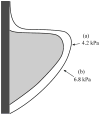Young's modulus of canine vocal fold cover layers
- PMID: 24491497
- PMCID: PMC4058419
- DOI: 10.1016/j.jvoice.2013.12.003
Young's modulus of canine vocal fold cover layers
Abstract
Objectives: The objective of this study was to measure the elastic modulus (Young's modulus) of canine vocal fold cover layers.
Study design: Basic science study.
Methods: Cover layers from vocal folds of eight canine larynges were dissected. Cover layer samples from the mid-membranous, medial vocal fold surface area were used to measure material stiffness using a previously validated indentation method. Cover layers from two human larynges were also measured as control references. Superior and inferior medial cover layers were measured separately. A total of 15 superior medial surface and 17 inferior medial surface specimens from the canine and two and four specimens, respectively, from the human were tested.
Results: In the canine larynges, the mean Young's modulus of the superior medial surface was 4.2 kPa (range, 3.0-5.4 kPa; standard deviation [SD], 0.6 kPa) and of the inferior medial surface was 6.8 kPa (range, 5.4-8.5 kPa; SD, 0.8 kPa). Measurements on human cover samples were 5.0 kPa (range, 4.7-5.4 kPa; SD, 0.5 kPa) and 7.0 kPa (range, 6.7-7.3 kPa; SD, 0.3 kPa) for the superior medial and inferior medial surface, respectively. Human measurements were similar to the previously validated measurements. There was no difference between the stiffness measurements in the human and canine cover layer samples (P>0.05).
Conclusions: The elastic stiffness (Young's modulus) of the canine and human vocal fold cover layers is similar. Findings support the use of canine larynx as an externally valid model to study voice production.
Keywords: Indentation; Laryngeal physiology; Vocal fold; Young's modulus.
Copyright © 2014 The Voice Foundation. Published by Mosby, Inc. All rights reserved.
Conflict of interest statement
Conflict of Interest: None
Figures


References
-
- Berke, Gerald S, Moore Dennis M, Hanson David G, Hantke David R, Gerratt Bruce R, Burstein Fernando. Laryngeal modeling: theoretical, in vitro, in vivo. The Laryngoscope. 1987;97:871–881. - PubMed
Publication types
MeSH terms
Grants and funding
LinkOut - more resources
Full Text Sources
Other Literature Sources

